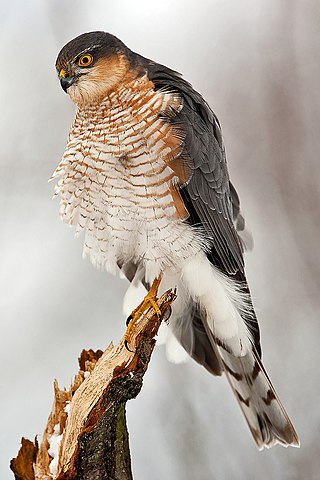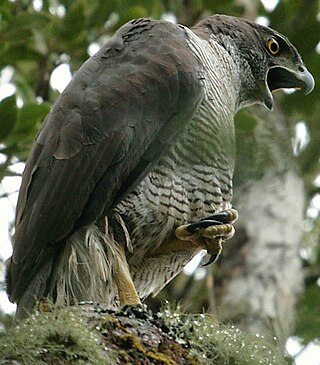
Hawks are birds of prey of the family Accipitridae. They are very widely distributed and are found on all continents except Antarctica.

The Accipitridae is one of the four families within the order Accipitriformes, and is a family of small to large birds of prey with strongly hooked bills and variable morphology based on diet. They feed on a range of prey items from insects to medium-sized mammals, with a number feeding on carrion and a few feeding on fruit. The Accipitridae have a cosmopolitan distribution, being found on all the world's continents and a number of oceanic island groups. Some species are migratory. The family contains 256 species which are divided into 12 subfamilies and 75 genera.

Accipiter is a genus of birds of prey in the family Accipitridae. Most species are called sparrowhawks, but there are many sparrowhawks in other genera too, such as Tachyspiza.

The Buteoninae are a subfamily of birds of prey which consists of medium to large, broad-winged species.

The Accipitrinae are the subfamily of the Accipitridae often known as the "true" hawks. The subfamily contains 73 species that are divided into 11 genera. It includes the genus Accipiter which formerly included many more species. The large genus was found to be non-monophyletic and was split into several new or resurrected genera. The birds in this subfamily are primarily woodland birds that hunt by sudden dashes from a concealed perch, with long tails, broad wings and high visual acuity facilitating this lifestyle.

The shikra is a small bird of prey in the family Accipitridae found widely distributed in Asia and Africa where it is also called the little banded goshawk. The African forms may represent a separate species but have usually been considered as subspecies of the shikra. The shikra is very similar in appearance, as well as behavior, at least to some degree, to other species including the Chinese sparrowhawk, Eurasian goshawk and Eurasian sparrowhawk. They have a sharp two note call and have the typical flap and glide flight. Their calls are imitated by drongos and the common hawk-cuckoo resembles it in plumage. This species was formerly placed in the genus Accipiter.

The lizard buzzard, or lizard hawk, is a bird of prey in the family Accipitridae. It is the only species placed in the genus Kaupifalco. It is native to Sub-Saharan Africa. Despite its name, it may be more closely related to the Accipiter hawks than the Buteo buzzards.

The crested goshawk is a bird of prey in the family Accipitridae that is widely distributed in tropical Asia. It was formerly placed in the genus Accipiter.

Frances's sparrowhawk is a small bird of prey. This species was formerly placed in the genus Accipiter. The nominate subspecies, T. f. francesiae, is endemic to Madagascar, and the other subspecies are found in the Comoro Islands. The Anjouan sparrowhawk, also known as the Anjouan Island sparrowhawk, Ndzuwani goshawk or Joanna Island goshawk, was thought to be extinct until searches in the 1980s and in 2005 confirmed that it is still extant.

The brown goshawk is a medium-sized bird of prey in the family Accipitridae found in Australia and surrounding islands. This species was formerly placed in the genus Accipiter.

The grey goshawk is a strongly built, medium-sized bird of prey in the family Accipitridae that is found in eastern and northern Australia. The white morph of this species is known as the white goshawk. This species was formerly placed in the genus Accipiter.

The tiny hawk is a small diurnal bird of prey found in or near forests, primarily humid, throughout much of the Neotropics. It is primarily a bird-eater, and is known to prey on hummingbirds.

The semicollared hawk is a rare bird of prey species in the family Accipitridae. It is found in Colombia, Ecuador, Peru, and Venezuela. Its natural habitat is subtropical or tropical moist montane forests. It is potentially being affected by habitat loss.

Henst's goshawk is a species of bird of prey in the family Accipitridae. It was formerly placed in the genus Accipiter. It is a large, diurnal bird endemic to the island of Madagascar. It is an obligate forest species that occurs at very low densities on the island and is rarely seen. It can only occupy the primary and secondary forests found within the island. Its natural habitats are subtropical or tropical dry forest, subtropical or tropical moist lowland forest, subtropical or tropical moist montane forest, and plantations. It is threatened by habitat loss within Madagascar.

The black-mantled goshawk is a species of bird of prey in the family Accipitridae. It is found in the highlands of New Guinea. Its natural habitat is subtropical or tropical moist lowland forests. This species was formerly placed in the genus Accipiter.

The little sparrowhawk is a species of Afrotropical bird of prey in the family Accipitridae. It was formerly placed in the genus Accipiter. It is the smallest member of the genus Tachyspiza and forms a superspecies with the red-thighed sparrowhawk.

Lophospiza is a genus of Asian birds of prey in the family Accipitridae. It is the only genus in the subfamily Lophospizinae. The two species placed in this genus were formerly placed in the genus Accipiter.

Astur is a genus containing hawks, goshawks and sparrowhawks in the family Accipitridae. The species were formerly placed in the genus Accipiter.

Aerospiza is a genus containing goshawks and a sparrowhawk in the family Accipitridae that are found in Africa. The three species in the genus were formerly placed in the genus Accipiter.

Harpaginae is a subfamily of the bird of prey family Accipitridae. The species are found in Central and South America.



















